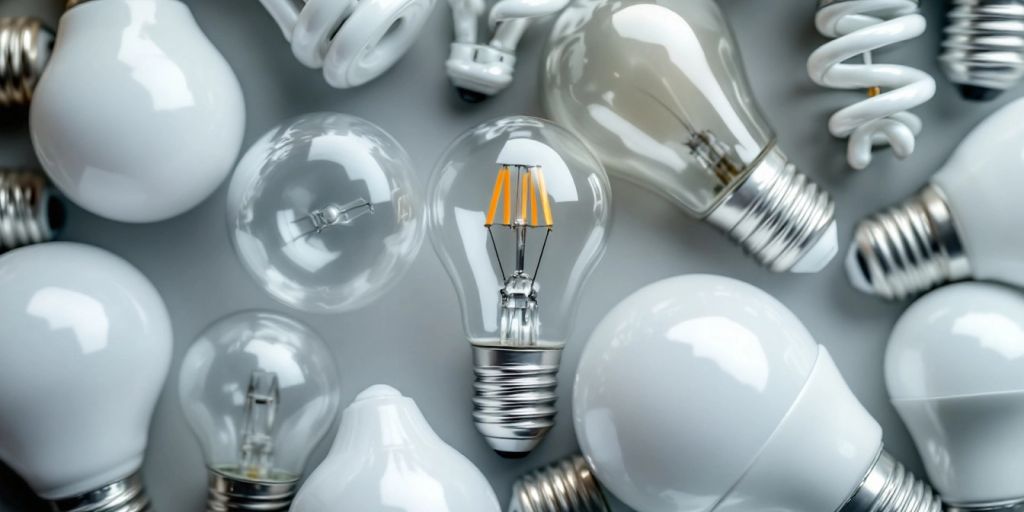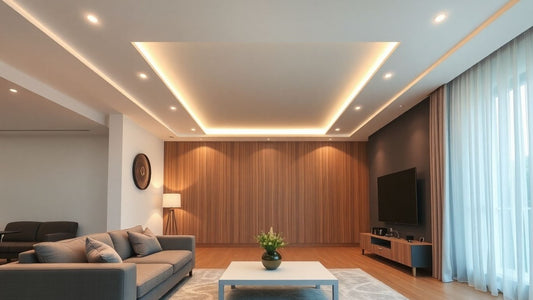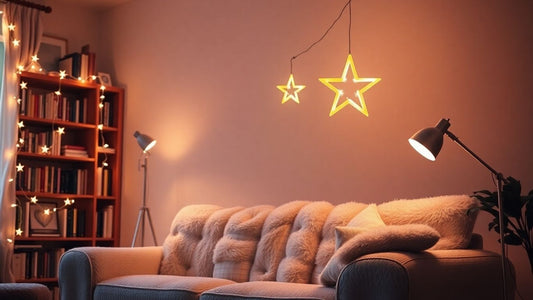Understanding Light Bulb Wattage: How to Choose the Right One for Your Home
Choosing the right light bulb wattage is essential for safety, efficiency, and comfort in your home. Understanding how wattage affects brightness and energy consumption can help you make informed decisions when selecting light bulbs for different fixtures and spaces. This article will guide you through the importance of light bulb wattage, how to choose the right wattage, and common mistakes to avoid.
Key Takeaways
- Wattage indicates how much power a light bulb uses; higher wattage doesn't always mean brighter light.
- Always check the maximum wattage rating for your fixtures to prevent safety hazards.
- LED bulbs are more efficient, providing more lumens per watt compared to traditional bulbs.
- Consider the size and function of each room when selecting bulb wattage for optimal comfort.
- Be aware of the different types of bulbs and their wattage equivalents to ensure proper lighting.
The Importance of Light Bulb Wattage
When it comes to lighting your home, understanding light bulb wattage is crucial. Wattage indicates how much power a light bulb uses, but it doesn't directly measure brightness. Instead, brightness is measured in lumens. For example, a typical E12 bulb wattage can range from 4 to 60 watts, while an E14 bulb lumens rating can vary significantly depending on the type of bulb used.
Understanding Wattage and Lumens
Wattage is important because it helps you determine how much energy a light bulb will consume. Here’s a quick comparison of common bulb types:
| Bulb Type | Wattage (W) | Lumens (lm) | Lifespan (hours) |
|---|---|---|---|
| Incandescent | 60 | 800 | 1,000 |
| LED | 10 | 800 | 15,000 |
| CFL | 15 | 800 | 10,000 |
| Halogen | 43 | 800 | 2,000 |
Safety Concerns with Incorrect Wattage
Using a bulb with too high a wattage can lead to overheating, which poses safety risks such as:
- Fire hazards
- Damage to light fixtures
- Melting of wiring insulation
Always check the maximum wattage rating for your fixtures to avoid these issues.
Energy Efficiency and Cost Savings
Choosing the right wattage can also lead to significant cost savings. For instance, switching from incandescent bulbs to LED bulbs can reduce energy consumption by up to 80%. Here are some benefits of using energy-efficient bulbs:
- Longer lifespan (e.g., E12 bulb lifespan can reach 15,000 hours for LEDs)
- Lower electricity bills
- Reduced environmental impact
Remember: Selecting the right wattage not only ensures safety but also enhances energy efficiency in your home.
By understanding the relationship between wattage and lumens, you can make informed decisions that improve both the safety and efficiency of your home lighting.
Choosing the Right Wattage for Different Fixtures
When selecting the right wattage for your light fixtures, it’s essential to consider the specific needs of each type of fixture. Using the correct wattage ensures safety and efficiency.
Ceiling Light Fixtures
For ceiling lights, always check the label on the fixture for its maximum wattage. Here are some key points to remember:
- Single fixtures usually have a clear wattage limit.
- If a fixture holds multiple bulbs, ensure the total wattage does not exceed the limit.
- Exceeding this limit can lead to overheating and potential fire hazards.
Table Lamps and Floor Lamps
Most lamps will have a maximum wattage indicated on their labels. If it’s not visible, contact the manufacturer for guidance. Generally:
- The typical maximum wattage for lamps is around 60 watts.
- LED bulbs are a great choice as they provide the same brightness with lower wattage.
- Consider using vanity light e27 bulbs for stylish and efficient lighting options.
Outdoor Lighting Solutions
Outdoor fixtures often require different considerations:
- Ensure the bulbs are rated for outdoor use to withstand weather conditions.
- Check the wattage limits to avoid overheating.
- Use lower wattage bulbs for decorative lighting and higher wattage for security lighting.
Choosing the right wattage for your fixtures not only enhances the ambiance of your home but also ensures safety and energy efficiency.
By understanding the wattage requirements for different fixtures, you can create a well-lit and safe environment in your home.
Comparing Different Types of Light Bulbs

When it comes to light bulbs, there are several types to consider, each with its own benefits and drawbacks. Understanding these differences can help you make the best choice for your home.
Incandescent vs LED
- Incandescent light bulbs are traditional and provide a warm light, but they are less energy-efficient. They typically range from 15W to 150W.
- LED light bulbs are much more energy-efficient, using about 80% less energy than incandescent bulbs. For example, a 10W LED can produce the same brightness as a 60W incandescent bulb.
- Lifespan: Incandescent bulbs last about 1,000 hours, while LEDs can last up to 25,000 hours.
Halogen vs CFL
- Halogen bulbs are a type of incandescent that is more efficient and has a longer lifespan, but they can get very hot and are more expensive to run.
- CFL (Compact Fluorescent Lamp) bulbs use about 70% less energy than incandescent bulbs and can last up to 10,000 hours. They are a good middle ground between incandescent and LED.
- Brightness: CFLs take a moment to warm up to full brightness, unlike halogen bulbs which reach full brightness instantly.
Specialty Bulbs and Their Uses
- Smart bulbs allow for remote control and can change colours, making them versatile for different moods and settings.
- Vintage E27 bulbs offer a decorative touch and are often used in exposed fixtures for aesthetic appeal.
- Reflector bulbs focus light in one direction, making them ideal for spotlights and outdoor lighting.
| Type of Bulb | Energy Use (W) | Lifespan (Hours) | Brightness Equivalent (W) |
|---|---|---|---|
| Incandescent | 60 | 1,000 | 60 |
| LED | 10 | 25,000 | 60 |
| Halogen | 43 | 2,000 | 60 |
| CFL | 13 | 10,000 | 60 |
Choosing the right type of light bulb can significantly impact your energy bills and the overall comfort of your home. Consider factors like light bulb socket types and light bulb colour temperature when making your selection.
For those looking to buy light bulbs online, options like E27 light bulbs are widely available, including LED E27 bulbs and vintage E27 bulbs. Always check for light bulb reviews to ensure you are making an informed choice!
How to Read Light Bulb Packaging

Understanding how to read light bulb packaging is essential for making the right choice for your home. The packaging contains important information that can guide your selection.
Wattage and Lumen Ratings
When looking at light bulb packaging, you will often see both wattage and lumen ratings. Here’s what they mean:
- Wattage indicates the amount of energy the bulb uses.
- Lumens measure the brightness of the bulb. The higher the lumens, the brighter the light.
| Type of Bulb | Wattage (Incandescent) | Equivalent LED Wattage | Lumens |
|---|---|---|---|
| Standard | 60W | 8-10W | 800 |
| Bright White | 100W | 16-20W | 1600 |
| Soft White | 75W | 10-12W | 1100 |
Energy Efficiency Labels
Look for energy efficiency labels on the packaging. These labels help you understand how much energy the bulb will consume over time. Here are some key points:
- A++ to E ratings indicate the efficiency level, with A++ being the most efficient.
- Check the estimated yearly energy cost, which can help you save money in the long run.
- LED bulbs typically have the best ratings, making them a great choice for energy savings.
Safety Certifications
Safety certifications are crucial for ensuring that the bulb is safe to use. Look for:
- CE Mark: Indicates compliance with European safety standards.
- RoHS: Ensures the bulb is free from hazardous materials.
- UL or ETL: These marks show that the bulb has been tested for safety in the USA.
Always check the packaging for the correct light bulb installation instructions to avoid any mishaps.
In summary, understanding how to read light bulb packaging can help you make informed decisions. Whether you need a B22 bulb replacement or a specific type for your B22 bulb socket, knowing what to look for will ensure you choose the right bulb for your needs.
Practical Tips for Selecting Light Bulb Wattage
Assessing Room Size and Function
When choosing the right wattage for your light bulbs, consider the size and purpose of each room. Here are some tips:
- Living rooms may require higher wattage bulbs for a warm and inviting atmosphere.
- Kitchens benefit from bright lighting, so opt for bulbs with higher lumens.
- Bedrooms should have softer lighting for relaxation, so lower wattage is often better.
Considering Colour Temperature
The colour temperature of a bulb affects the mood of a room. Here’s a quick guide:
- Warm white (2700K-3000K): Ideal for living spaces and bedrooms.
- Cool white (3500K-4100K): Great for kitchens and workspaces.
- Daylight (5000K-6500K): Best for reading areas or places needing bright, clear light.
Balancing Brightness and Comfort
Finding the right balance between brightness and comfort is essential. Here are some points to consider:
- Use a light bulb buying guide to understand the wattage and lumens needed for your fixtures.
- E27 bulb wattage typically ranges from 9W to 15W for LED options, providing ample brightness without excessive energy use.
- E14 bulb wattage is often lower, making it suitable for decorative fixtures.
Remember, using the right wattage not only enhances your home’s comfort but also ensures safety. Always check the maximum wattage for your fixtures to avoid hazards.
Summary Table of Common Bulb Types
| Bulb Type | Wattage | Lumens | Colour Temperature |
|---|---|---|---|
| E27 LED | 9-15W | 800-1600 LM | 2700K-6500K |
| E14 LED | 6-10W | 400-800 LM | 2700K-6500K |
| B22 LED | 10-15W | 800-1600 LM | 2700K-6500K |
By following these practical tips, you can select the right wattage for your light bulbs, ensuring a well-lit and comfortable home environment.
Common Mistakes to Avoid When Choosing Light Bulb Wattage
When selecting the right wattage for your light bulbs, it's easy to make mistakes that can lead to safety issues or inefficient lighting. Here are some common pitfalls to avoid:
Overlooking Fixture Limits
- Always check the maximum wattage rating on your light fixtures. Using a bulb with too high a wattage can cause overheating and may even lead to a fire.
- For fixtures with multiple bulbs, ensure the total wattage does not exceed the combined limit.
- Remember that some fixtures, like lamps, often have a lower wattage limit than ceiling lights.
Ignoring Energy Efficiency
- Many people still choose incandescent bulbs without considering more efficient options. Switching to LED or CFL bulbs can save you money on energy bills.
- Look for bulbs with a high lumen-to-watt ratio to maximise brightness while minimising energy use.
- Consider the long-term savings of energy-efficient bulbs, which last much longer than traditional options.
Mismatching Bulb Types
- Different types of bulbs (like b22 bulbs) have varying wattage requirements. Make sure to understand the differences between incandescent, halogen, CFL, and LED bulbs.
- Using the wrong type of bulb can lead to poor lighting quality or even damage to your fixtures.
- Always refer to the packaging for wattage equivalencies when switching bulb types.
Choosing the right wattage is crucial for both safety and efficiency. Always do your research before making a purchase to ensure you select the best option for your home.
When picking the right wattage for your light bulbs, it's easy to make mistakes. Many people either choose bulbs that are too bright or too dim for their needs. To avoid these common errors, take a moment to think about where you'll use the bulbs and how much light you really need. For more tips and to explore our wide range of bulbs, visit our website today!
Conclusion
In summary, selecting the right wattage for your light bulbs is crucial for both safety and comfort in your home. Always check the wattage limits on your fixtures and choose bulbs that match these ratings. Remember, higher wattage does not always mean brighter light; different types of bulbs produce varying brightness levels for the same wattage. By understanding your lighting needs and opting for energy-efficient options like LED bulbs, you can create a well-lit and inviting space while saving on energy costs. So, take the time to choose wisely and enjoy the benefits of the right lighting in your home.
Frequently Asked Questions
What does wattage mean in light bulbs?
Wattage shows how much power a light bulb uses. A higher wattage means more energy and usually more brightness.
Can I use a higher wattage bulb than recommended?
No, using a bulb with higher wattage than the fixture allows can cause overheating and may lead to fire hazards.
What is the best wattage for a living room?
For a living room, using bulbs between 60 to 100 watts is common, but it also depends on the size of the room and how much light you want.
How do I know what wattage to use in my lamp?
Check the label on your lamp or its socket. It usually tells you the maximum wattage you can use.
What is the equivalent wattage of an LED bulb compared to incandescent?
An LED bulb usually uses about 8 to 10 watts to give the same brightness as a 60-watt incandescent bulb.
Why should I choose LED bulbs over incandescent?
LED bulbs use less energy, last longer, and save you money on electricity bills compared to incandescent bulbs.



